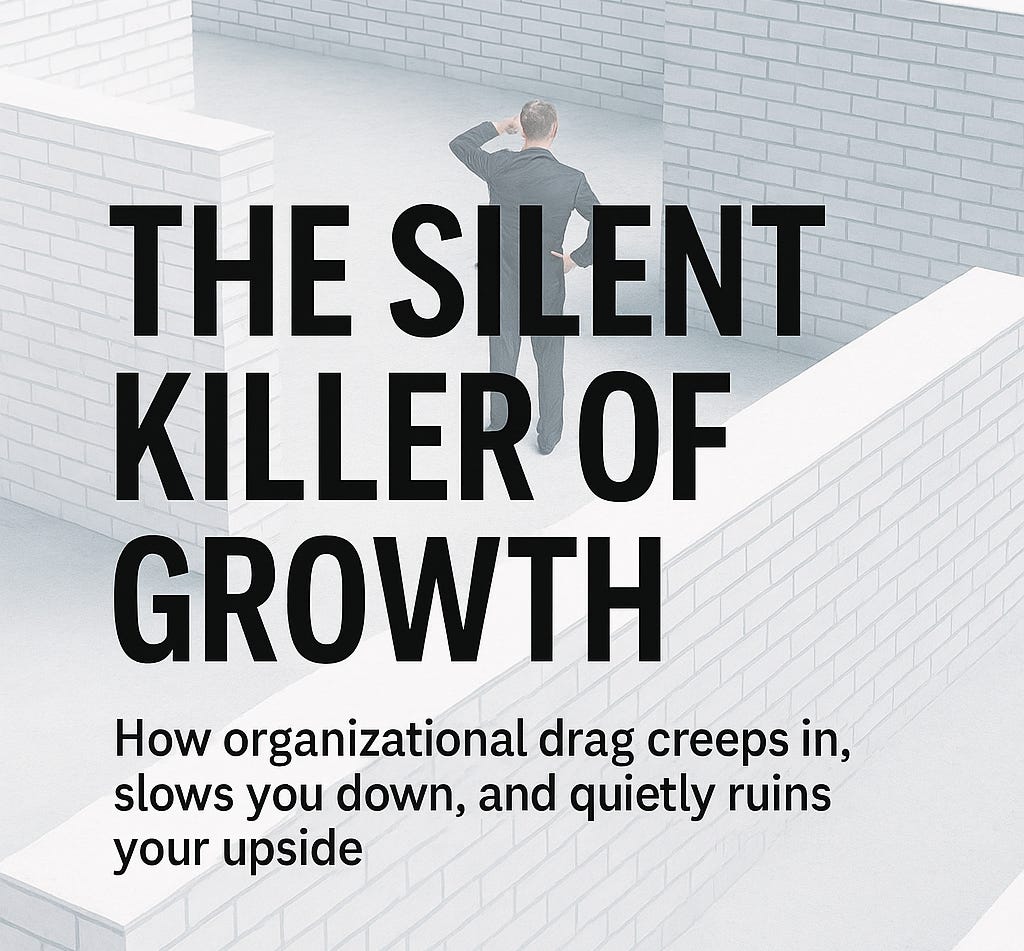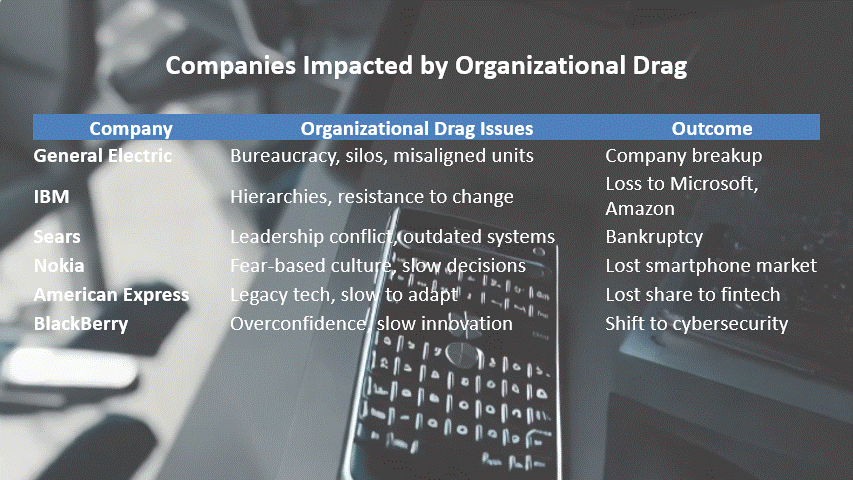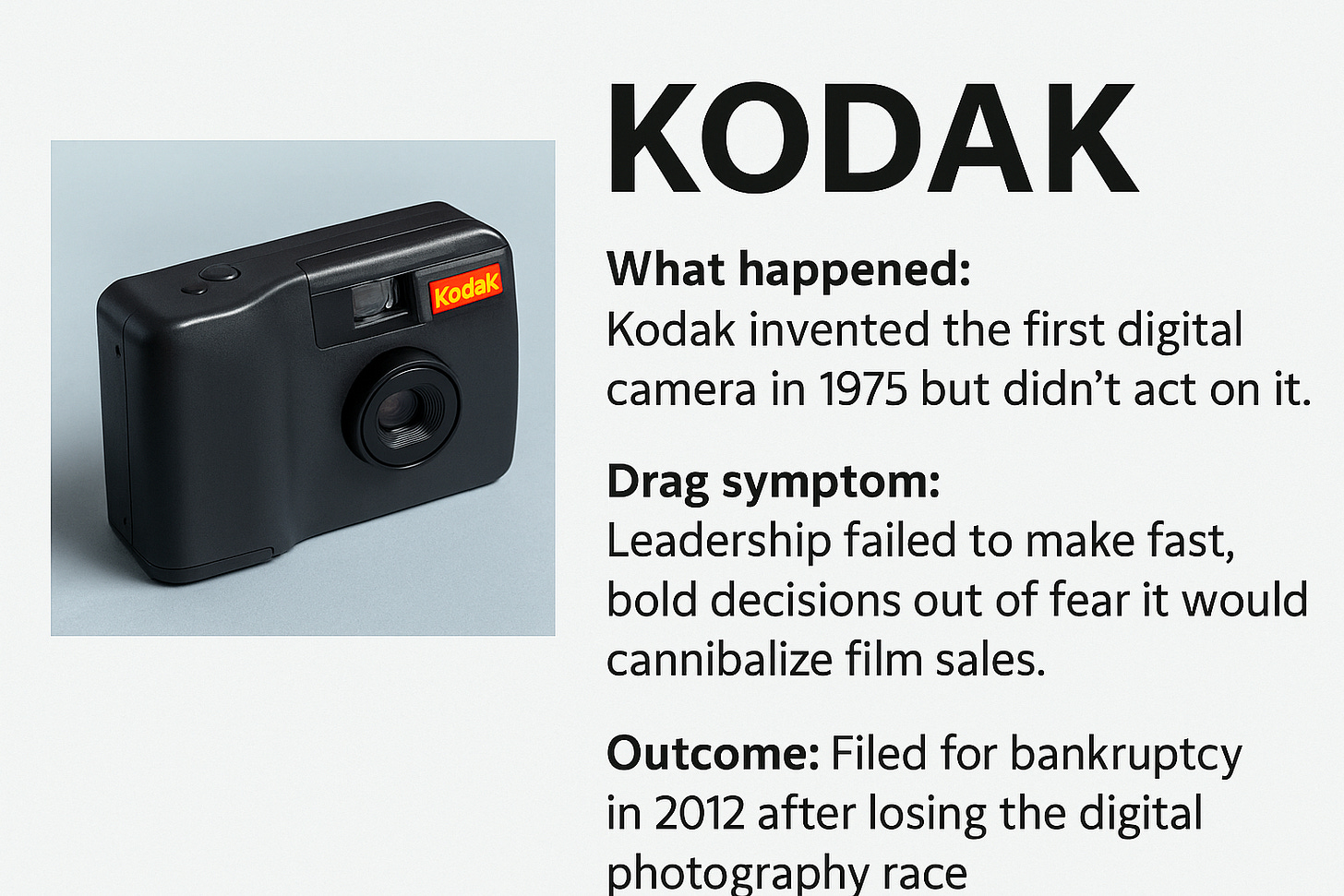The Silent Killer of Growth
How organizational drag creeps in, slows you down, and quietly ruins your upside.
Beware the Invisible Anchor
I’ve observed more companies falter due to internal friction than from any fierce competitor. You know the feeling: decisions that used to take an hour now require committee approval and three follow-up meetings.
Your once-agile startup now moves as if it's stuck in molasses. The problem isn't the market or a lack of talent; it's something hidden within your organization. It’s referred to as organizational drag, and it serves as a silent killer of growth. Too often, it goes unnoticed until it starts to choke your momentum.
Organizational drag is comparable to cholesterol in a corporation: it accumulates slowly and unnoticed. Initially, a new approval process or an additional layer of procedures might appear harmless, even beneficial for creating “structure.” However, over time, these small changes accumulate and become a significant burden.
In practical terms, organizational drag refers to the unnecessary meetings, redundant approvals, endless email chains, and cumbersome processes that make work feel more difficult than it needs to be. If you’ve ever wondered, “Why do we need three people to approve a simple marketing campaign?” you’ve experienced organizational drag.
Small inefficiencies and misalignments accumulate, acting as an anchor on your company’s speed.
What Is Organizational Drag?
(In Plain English)
Organizational drag refers to the unnecessary burdens your organization carries that do not create value, essentially the opposite of operating efficiently. It manifests as cumulative internal inefficiencies that slow down decision-making, hinder innovation, and reduce responsiveness.
In plain English, it’s the friction in your day-to-day work. Think of needless internal interactions, unproductive or inconsequential meetings, and excessive email chains, all the things that waste time and sap energy.
Every organization has some of this, but high-growth companies are especially vulnerable. Why? Success breeds complexity. As you hire and scale, suddenly there are new departments, more stakeholders, and a process for everything.
What started as a nimble sprint turns into a bureaucratic shuffle. I’ve heard it described as “the mud that middle management drags you through,” and that’s not far off.
When a company is small, you can quickly notice any inefficiencies, but as it grows, these issues can become less visible. Organizational drag is like sand in your gears, often created by the company itself as it adds more people and processes in the pursuit of growth. Ironically, this can end up being the very thing that hinders further growth.
The Hidden Costs of Drag
You might think, “Sure, we have some red tape, but is it that bad?” The answer is yes, and then some. Organizational drag carries hidden costs that quietly erode your business from the inside.
First and foremost, it decimates productivity. Time spent navigating internal hurdles is not spent on serving customers, improving products, or seizing new opportunities.
Consider this: one analysis found that the average executive receives ten times as many communications today as they did 20 years ago and spends 23 hours weekly in meetings.
That’s a massive chunk of the week lost to inboxes and conference rooms. Multiply those wasted hours across a company, and you’re looking at an enormous opportunity cost in output. According to the data, the impact is $ 37 Bn lost annually.
Slow decision-making is another silent killer. When every minor decision requires a symphony of consensus, your organization loses agility. Opportunities don’t wait around.
If your team takes weeks to decide on a pricing change or approve a pilot project, faster competitors will take advantage of that delay. I've witnessed deals fall through and product launches miss their opportunity because internal processes moved too slowly.
The financial hit from these missed opportunities can dwarf any savings you think bureaucracy provides.
Then there’s the human cost. Talented people hate wasting their time. Organizational drag drains morale and breeds frustration among your best and brightest. Top performers will either disengage or head for the exits if they feel like they’re slogging through unnecessary sludge every day.
Disengaged employees cost U.S. companies between $450 billion to $550 billion annually in lost productivity.
As one Fortune 500 CEO put it, bureaucracy is a “disease” that “drives out good people, slows down decision making, and kills innovation.” In other words, drag doesn’t just slow your current operations, it actively repels the very people who could help you fix it.
And let’s not forget the cultural impact: when employees see that inertia and internal politics consistently trump results, it crushes their ownership mindset and willingness to go the extra mile. In sum, organizational drag quietly saps your organization’s time, money, and spirit.
Spotting the Drag: A Quick Self-Diagnostic
Organizational drag often goes unnoticed until it becomes severe, but there are warning signs if you know where to look. The following questions may help guide you to uncover areas:
Do decisions that used to take an hour now take a week? (Be honest. How many layers of approval or rounds of meetings does a simple decision really require?)
Are your team members drowning in internal meetings and emails? (Look at your calendar: if it’s filled with back-to-back internal check-ins, you’re probably dealing with drag.)
Have you noticed great employees becoming disengaged or leaving despite strong company prospects? (Frustration with bureaucracy is a top reason rising stars exit.)
Is “I’m waiting on X department” a common excuse for missed deadlines? (When dependency bottlenecks and unclear ownership plague projects, drag is at play.)
Do new ideas or projects die in committee? (If initiative and creativity are smothered by analysis paralysis or endless vetting, you’ve got a drag problem.)
Does every decision need to go through you, and/or are individuals hesitant to make decisions? (We’ve all worked in that one company where decision-making was discouraged,)
If you found yourself nodding (or wincing) at more than one of these, your organization may be carrying more drag than you realize. The first step is acknowledging it.
You can't fix what you don't recognize. The goal is not to assign blame but to highlight the creeping bureaucracy, complexity, or bottlenecks that have developed over time.
Even in a well-managed company, process entropy is a natural occurrence. The key is to regularly diagnose and address these issues before they escalate into significant problems that hinder growth.
Cutting the Slack: How to Reduce Drag and Regain Speed
The good news is that organizational drag is not a terminal issue; it's more like high cholesterol. With some disciplined changes, you can reduce it and return your organization to a more agile state.
Here are a few effective strategies that I’ve observed to minimize drag and enhance nimbleness:
Clarify Decision Rights and Delegate Wisely: One of the quickest ways to reduce drag in an organization is by clearly defining who makes decisions. If every choice ends up at your desk or in a committee, that’s a problem. Push decisions down to those closest to the information and clarify “who has the D” for each decision. Set clear guardrails and trust your team to deliver.
Adopt a 90-Day Cadence: If strategy without execution is daydreaming, then long-term plans without short-term urgency are just wishful thinking. A 90-day cadence injects speed and focus by treating each quarter like a sprint. Set clear priorities for the next 90 days, with no more than three major initiatives, and rally the team around hitting those targets. You can still have a long-term vision, but you’re executing in bite-sized, urgency-infused chunks.
Streamline and Simplify Processes: Many teams struggle with complicated processes that often go unchallenged. Review your workflows and meetings. Are standing meetings truly necessary, or could a quick Slack update suffice? Is that multi-step approval process still valuable, or just a leftover from the past? Eliminate any steps that don’t pass the “so what?” test.
Leverage Fractional Leadership or Outside Experts: Sometimes, the fastest way to cut through internal drag is to bring in a fresh and experienced set of hands. Fractional leaders, such as part-time CFOs or COOs, can be a game-changer for growth-stage or PE-backed companies that need expertise without adding another full-time executive. These professionals arrive with clear mandates, whether it’s fixing broken operations or untangling stalled projects, and they carry no political baggage.
Instill a Culture of “Bias for Action”: Culture may seem soft, but it’s often what determines speed. When people fear mistakes, they slow down and hide behind process, which creates organizational drag. To counter that, reward action and learning, not just perfection. Let your team know that speed matters and smart risks are safe.
The common theme among these strategies is intentionality, actively designing your organization for speed and simplicity, instead of allowing complexity and inertia to develop by default.
Case Studies in Cutting Through the Noise
Organizational drag isn’t unique to small or struggling companies; it also affects giants. However, the companies that overcome it all share one trait: a willingness to confront the slowdown head-on and make structural or cultural shifts to regain momentum.
Ford serves as a compelling example of a legacy company taking decisive action to overcome organizational challenges. For years, Ford's internal structure was hindered by outdated systems, overlapping teams, and slow decision-making processes. Despite having strong brand equity, the company struggled to compete with faster, tech-driven rivals in the electric vehicle market.
To address these issues, Ford restructured its business in 2022, dividing it into two distinct divisions: Ford Blue, which focuses on traditional gas-powered vehicles, and Ford Model e, dedicated to electric vehicles and software innovation. This was more than just a rebranding effort; it was a strategic move to separate innovation from bureaucracy. CEO Jim Farley emphasized that this separation was intended to enhance speed and focus.
The results have been promising. Ford Model e has attracted tech talent, shortened product development cycles, and started to close the competitive gap with electric vehicle leaders. Meanwhile, Ford Blue continues to generate significant cash flow without the burden of managing a transformation it was not designed for.
Microsoft is another case study in transformation. In the early 2010s, the company was famously known for internal turf wars. Different divisions operated like isolated kingdoms, competing more with each other than with external rivals. Under Satya Nadella’s leadership, Microsoft replaced that siloed structure with a unified “One Microsoft” approach.
Teams were realigned, incentives were overhauled, and collaboration replaced infighting. The cultural shift didn’t just improve morale; it unlocked faster innovation and helped drive Microsoft's dramatic growth in cloud computing.
Netflix also faced its form of organizational drag as it expanded globally. Headquarters held too much decision-making authority, slowing down regional teams that needed agility to serve diverse markets. Instead of tightening control, CEO Reed Hastings leaned harder into the company’s “freedom and responsibility” culture.
Local teams were empowered to act autonomously, allowing Netflix to operate with agility and precision across continents. The payoff was substantial: faster product cycles, market-specific content strategies, and explosive international growth.
The takeaway from these examples is clear. You don’t need a total overhaul to beat organizational drag, but you need courageous clarity. Whether it is decentralizing authority, eliminating unnecessary layers, or realigning team incentives, the companies that move fastest are the ones that strip away the sludge and let talent run.
Closing Thoughts
Organizational drag may be subtle, but as leaders, we cannot afford to ignore it. I encourage you to closely examine your own company with this in mind. Where are things getting stuck? What frustrations keep recurring?
In a world where speed is crucial, your role as a leader is to create an organization that operates smoothly and decisively. This involves consistently eliminating excess, whether it’s a redundant report, an unnecessary hire, or your own tendency to interfere in minor decisions.
The rewards are significant: a company that’s not just larger but also better, faster, more agile, and ready for growth.
The silent obstacle to growth doesn’t have to be detrimental. By identifying and addressing organizational drag directly, you can reclaim your company’s lost momentum.
In my experience, the difference between companies that plateau and those that continue to thrive lies in this: the leaders who are willing to challenge the status quo and relentlessly streamline processes are the ones who unlock the next level of scalability.
So, ask yourself: where is drag quietly undermining potential, and what steps will you take to address it? The sooner you take action, the sooner you will remove that invisible obstacle, and trust me, your future self will thank you as you watch your organization move forward with renewed energy.
Sources
Insights and data in this newsletter are drawn from publications and research, including:
Michael Mankins & Eric Garton, Time, Talent, Energy
Business Insider (various articles)
Lauren Carter, L.A. Consulting
Neha Goel, Medium (RightSize Collective)







Really enjoyed this piece, David. The idea of organizational drag as a “silent killer” of growth really hits home… especially the way small inefficiencies can snowball into real barriers. I’ve seen firsthand (in all sized organizations) how even well-intentioned processes can end up slowing teams down if left unchecked and unoptimized. Thanks for the reminder that speed and clarity aren’t just nice-to-haves, they’re strategic advantages for every business Great read! Have been enjoying your insightful article series! Especially the history of M&Ms… 😂
Really liked the examples. A couple ways I’ve headed off drag is: when I send something to a large group for review, I establish the quorum and let people know I’ll move forward by a certain date as long as certain people or certain number of people have provided input; I work through the admin system to get on leader’s calendars when I just need a few minutes to get sign off for the next step that will allow me to move forward; and I am getting to that courageous clarity you mention, by spending sufficient time nailing down critical elements like strategy and goals, thus empowering myself to lead and not wait.